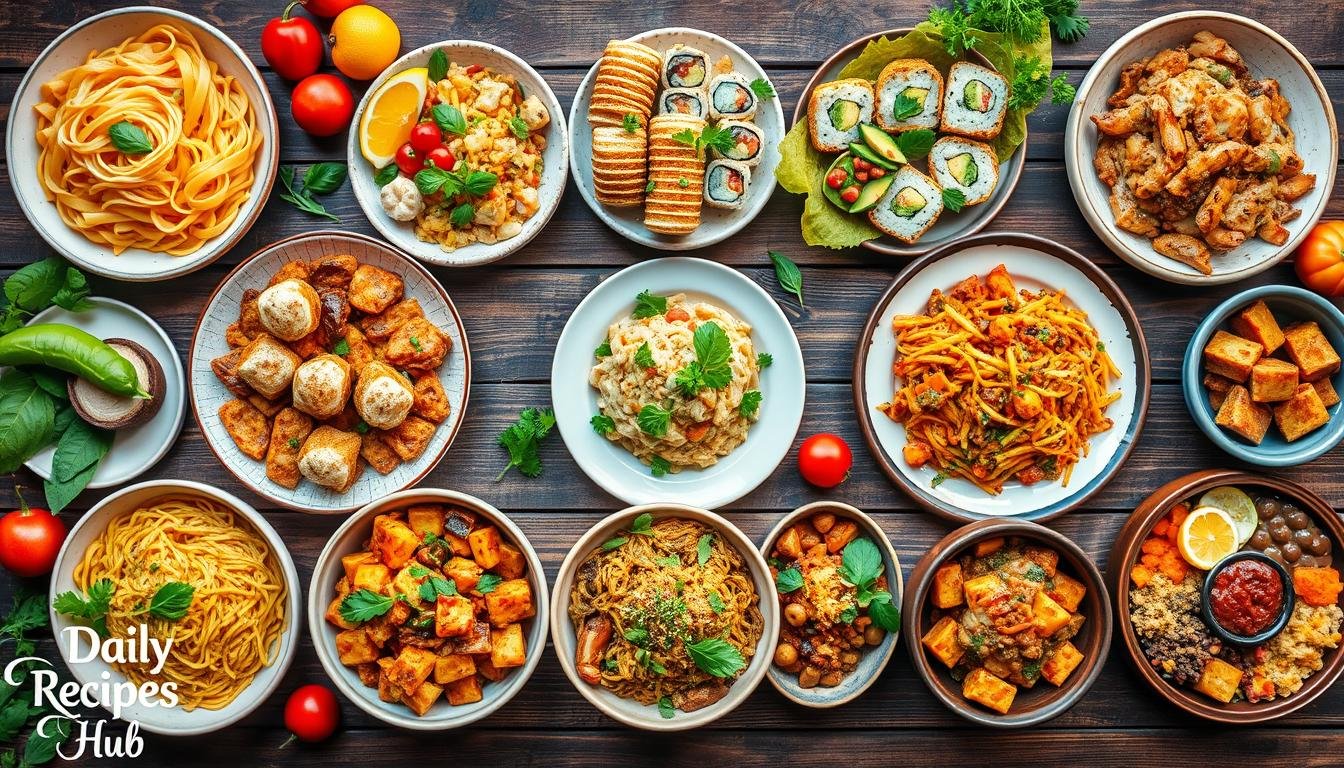Have you ever tasted a dish that took you to another world? The smells and tastes told stories from far-off places. Culinary experiences connect us deeply, mixing memories, heritage, and global flavors.
On this journey through 10 Must-Try Cultural Recipes, you’ll see food as more than food. It’s a celebration of tradition and love. Each dish shows the rich and varied international cuisine that makes our world special. It invites you to explore cultures from different continents.
So, get ready to enjoy not just the delicious tastes but also the stories behind these dishes.
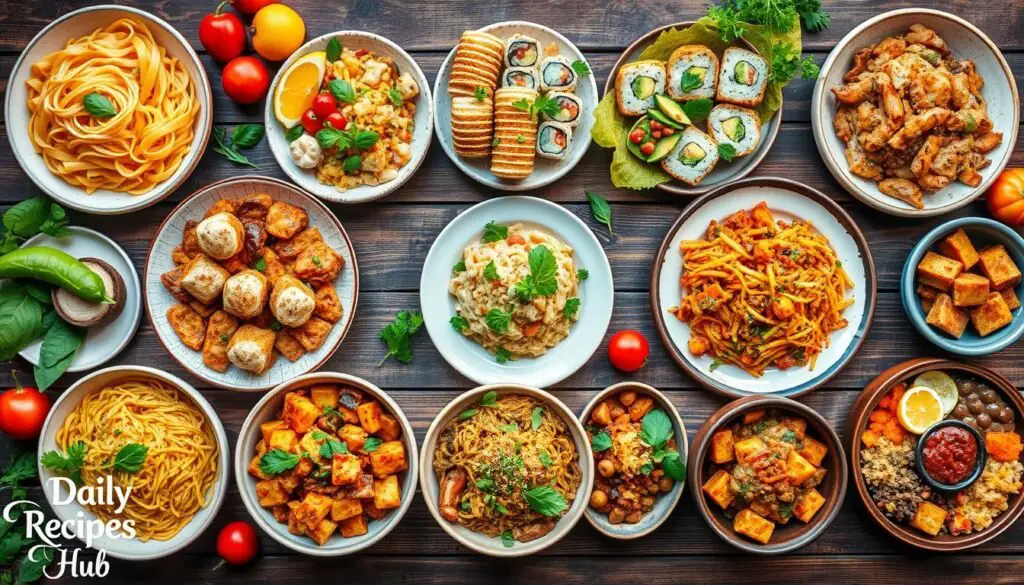
Key Takeaways
- Experience traditions through food with diverse cultural recipes.
- Discover global flavors that tell unique stories.
- Each dish reflects rich history and personal connections.
- Cooking these recipes opens up a world of international cuisine.
- Food is a universal language that transcends boundaries.
Introduction to Global Culinary Diversity
Exploring global culinary diversity shows a colorful mix of international food cultures and unique traditions. Each area around the world has its own ingredients, cooking styles, and history. For example, Australia has 80 culinary areas, blending flavors from its Indigenous people and diverse population.
Indigenous Australians have lived there for over 50,000 years. They add to the rich food scene.
Culinary traditions are very important. They connect families, build communities, and keep cultures alive. In many places, you can find different foods like Persian, Italian, and Vietnamese. This shows how diverse food cultures are today.
In Australia, people eat a lot of lamb, about 8.5 kg per person each year. This shows how certain tastes can be very popular.
Iconic dishes like meat pies are a symbol of national pride. There are competitions to find the best ones. These dishes are more than food; they share stories of the people who make them.
They celebrate heritage and community spirit. Traditional meals give us a peek into local customs. They help people feel connected to their culture.
Understanding and valuing this diversity helps us see the world’s kitchen in a new light. It shows how each culture adds to our global culinary experience.
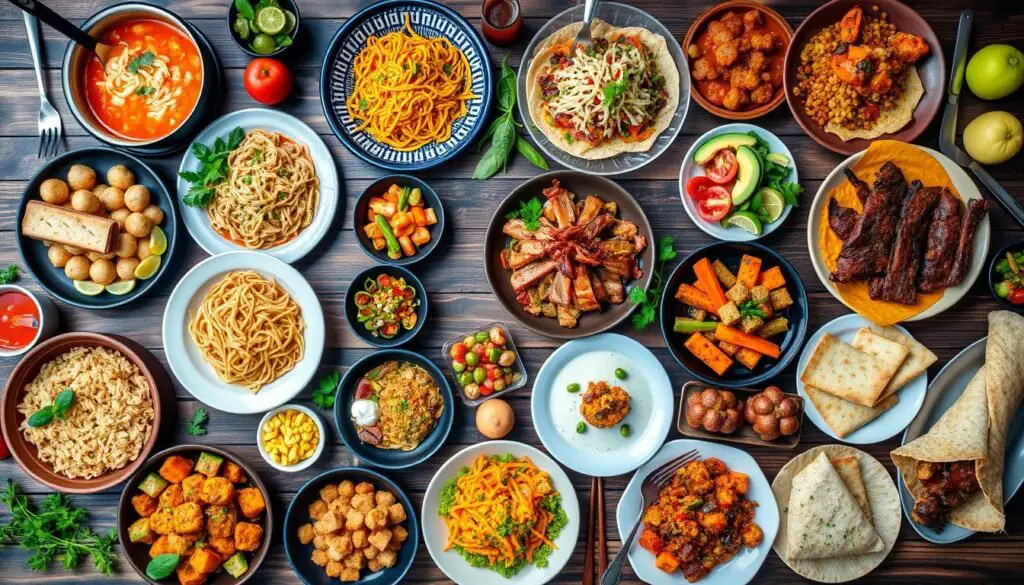
| Country | Key Dish | Average Consumption |
|---|---|---|
| Australia | Lamb | 8.5 kg per capita |
| Australia | Meat Pie | 1 per month |
| United Kingdom | Fish & Chips | N/A |
| Germany | Potato Dumplings | N/A |
| Italy | Pasta | N/A |
The Essence of Cultural Recipes
Cultural recipes are more than just food; they are traditions passed down through generations. Each dish tells a story of history and community. When we share these meals, we connect with our heritage and the people who made them.
Think about the variety of dishes around the world. Sushi shows Japanese precision, while paella highlights Spanish flavors. These recipes tell us about the culture and traditions of different communities.
At family gatherings, traditional foods like kimchi or burgers are often the main attraction. They symbolize more than just food; they represent warmth and togetherness. Exploring these recipes lets us taste different flavors and connect with our shared heritage.
| Dish | Country | Percentage of Households Enjoying |
|---|---|---|
| Sushi | Japan | N/A |
| Paella | Spain | 30% |
| Pho | Vietnam | 50% |
| Pizza Margherita | Italy | 75% |
| Pad Thai | Thailand | 35% |
| Moussaka | Greece | 40% |
| Tacos al Pastor | Mexico | 60% |
| Peking Duck | China | 20% |
| Ceviche | Peru | 45% |
| Burgers | USA | 60% |
Matjesbrötchen Recipe – Traditional German Fish Sandwich
Matjesbrötchen is a favorite in Northern Germany, known for its young pickled herring, or Matjes. It has been enjoyed for over a century. This dish is loved in Hamburg and Emden for its taste and history.
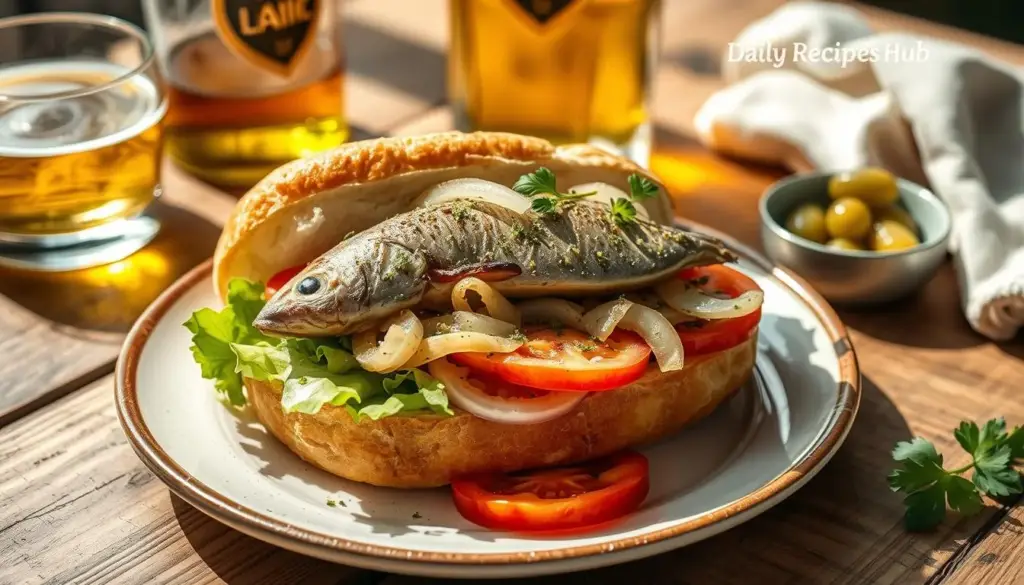
The Story and Origins
Matjesbrötchen comes from Northern Germany, where it celebrates coastal abundance and local traditions. Its history spans centuries. The Matjes herring, with its delicate flavor and buttery texture, is a key part of German cuisine.
Health Benefits
Fish, like Matjesbrötchen, is great for your heart. It’s full of omega-3 fatty acids. A 100g serving of Matjes herring has:
| Nutrient | Amount per 100g |
|---|---|
| Calories | 210 |
| Protein | 20g |
| Omega-3 Fatty Acids | 1.8g |
| Vitamin D | 15μg |
| Vitamin B12 | 10μg |
These nutrients make Matjesbrötchen a healthy choice for a meal or snack.
Key Highlights of Matjesbrötchen Recipe
To make a great Matjesbrötchen, you need to know its ingredients and how to prepare it. The main things are:
- 4 fillets of fresh Matjes herring
- 1 medium red onion, thinly sliced
- 4 small dill pickles
- 4 crusty Brötchen (German bread rolls)
- A squeeze of fresh lemon juice and dill for garnishing
This sandwich is often served open-faced. It lets you see its colors and textures. You can add things like horseradish or avocado. Serving it with German potato salad or coleslaw makes it even better. Matjesbrötchen is a true taste of German tradition and a healthy meal.
Eating Matjesbrötchen can make your diet more delicious while satisfying your taste buds. Learn more about the health benefits of Matjesbrötchen in this article.
Coal Miner’s Recipe for Sauerkraut – German Heritage
Coal Miner’s Sauerkraut is a symbol of German heritage. It has a long history, starting in ancient China and spreading to Europe. For miners, it was a vital food, full of nutrients during cold winters.
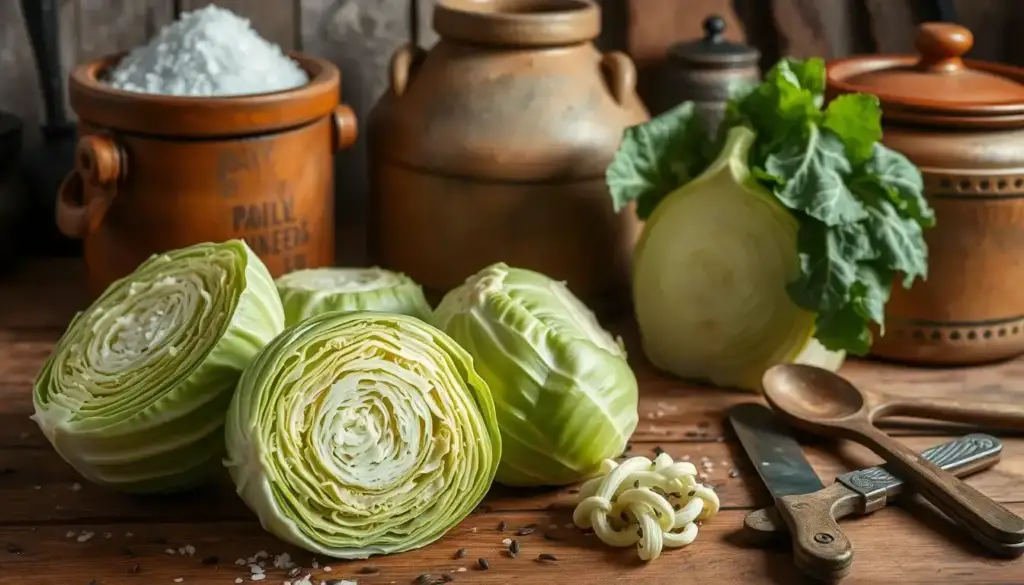
The Story and Origins
Coal miners created this dish due to their tough working conditions. Sauerkraut helped preserve cabbage, keeping it fresh during winter. It was a shared tradition, bringing miners and their families together.
Health Benefits
Sauerkraut is packed with health benefits. It’s full of probiotics, which help your digestion and immune system. It also has vitamins C and K, fiber, and antioxidants, making it a healthy choice.
Key Highlights of Coal Miner’s Recipe for Sauerkraut
Making Coal Miner’s Sauerkraut is simple and captures its traditional spirit:
- Ingredients: 2 medium heads of cabbage, 3 tablespoons non-iodized salt, optional spices like caraway seeds or bay leaves, along with apple cider or beer for flavoring.
- Preparation Time: 10 minutes
- Cooking Time: 30 minutes
- Total Time: 40 minutes
- Serving Size: 4 servings
- Calories per Serving: 250 kcal
- Fiber per Serving: 4g
The fermentation takes 7 to 10 days, depending on your home’s temperature and humidity. Keeping the temperature between 65-70°F (18-21°C) is key for the right flavor.
| Nutritional Value | Per Serving |
|---|---|
| Protein | 12g |
| Fat | 10g |
| Carbohydrates | 20g |
| Sodium | 800mg |
Adding this traditional sauerkraut to your meals honors a long tradition. It also brings healthy benefits to your diet.
Discover the traditional method of making Sauerkraut with our Coal Miners’ Recipe, passed down through generations. Read more at: Coal Miners’ Recipe for Sauerkraut – Authentic Family Method.
Leche de Tigre Recipe – Peruvian Ceviche Marinade
Leche de Tigre, or “tiger’s milk,” is key in Peruvian ceviche. It boosts the taste of fresh seafood and shows off Peru’s coastal culture. Its tangy, aromatic mix is a refreshing addition to ceviche, loved by many.
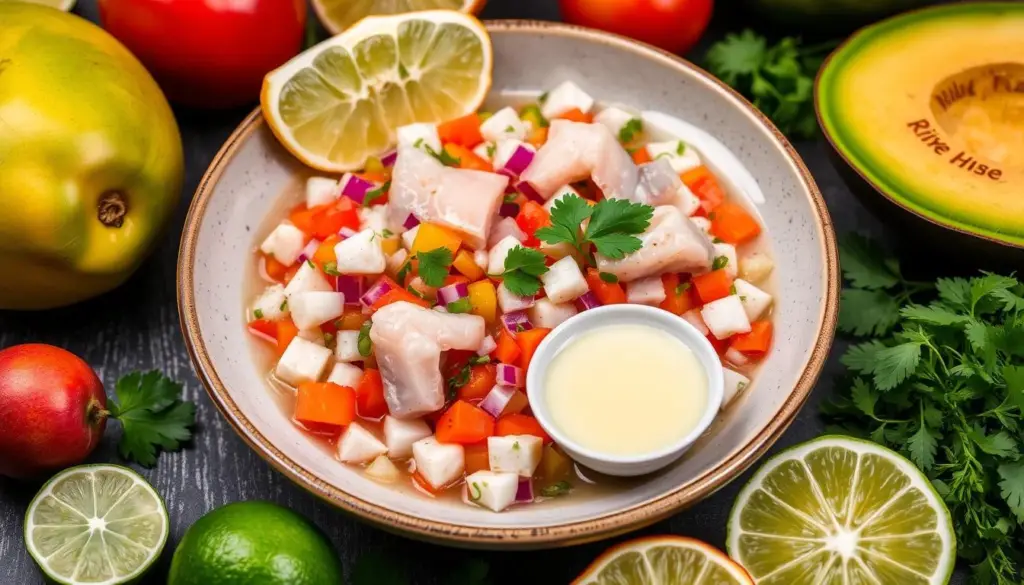
The Story and Origins
This blend comes from Peru’s shores and has been loved for over 2,000 years. It started with ceviche leftovers, showing local chefs’ creativity. Made with lime juice, fish stock, and spices, it captures the essence of fresh seafood and traditional cooking.
Health Benefits
Leche de Tigre is packed with health benefits. It’s high in protein and low in calories, making it a nutritious choice. Lime juice adds flavor and vitamin C, boosting immune health. Fish in it also provides omega-3s, good for the heart.
Key Highlights of Leche de Tigre Recipe
Making Leche de Tigre is easy and rewarding. Here are the main ingredients and ways to serve it:
- 125ml (½ cup) of lime juice
- 60ml (4 tbsp) of lemon juice
- 70g (2oz) of white fish
- 100ml (3fl oz) of white fish stock
You can drink it on its own or use it to make ceviche better. For the best taste, use fresh ingredients. Adding diced onions or cilantro can also enhance the flavor.
| Nutritional Information | Per Serving |
|---|---|
| Calories | 284 |
| Protein | 10.8g |
| Total Fat | 20.1g |
| Saturated Fat | 4.1g |
| Carbohydrates | 18.9g |
| Fiber | 2.4g |
| Sodium | 575mg |
Learn how to make the perfect Easy Leche de Tigre with this simple recipe. Find out more at: Easy Leche de Tigre Recipe.
Traditional Moroccan Chicken Couscous Recipe with Apricot Preserves – Moroccan Classic
Explore the rich flavors of Morocco with the Moroccan Chicken Couscous. It’s perfect for big gatherings and special events. The dish combines savory and sweet, with apricot preserves adding a sweet touch.
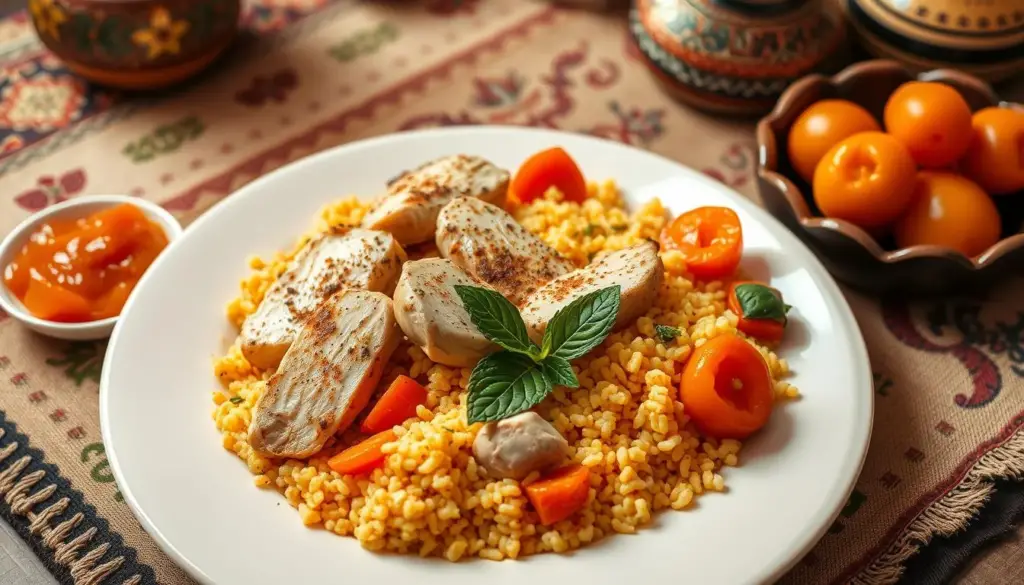
The Story and Origins
The Moroccan Chicken Couscous has become a favorite, deeply rooted in Moroccan cooking. It uses couscous, a staple made from durum wheat. Spices like saffron, cinnamon, and cumin give it a unique taste. This recipe is a mix of Arab, Berber, and Mediterranean flavors.
Health Benefits
This dish is not only tasty but also healthy. Couscous is a good carb source, and chicken thighs add protein. Apricots add fiber and vitamins. Eating Moroccan Chicken Couscous helps you eat well and enjoy your meals.
Key Highlights of Traditional Moroccan Chicken Couscous Recipe with Apricot Preserves
- Couscous is steamed for 10-15 minutes, making it light and fluffy.
- Using 6 chicken thighs with skin and bones adds flavor and tenderness.
- 1 cup of apricot preserves brings a sweet and tangy flavor.
- Spices like cumin, cinnamon, and saffron add depth to the dish.
- This recipe serves 4, great for family meals.
- It takes about 50 minutes to prepare and cook, efficient yet quality.
- Leftovers can be kept for up to 3 days, handy for busy homes.
Experience the rich flavors of traditional Moroccan Chicken Couscous with Apricot Preserves. Discover the full recipe at: Traditional Moroccan Chicken Couscous Recipe.
Benihana Chicken Fried Rice Recipe — Japanese-American Fusion
The Benihana Chicken Fried Rice is a true fusion of Japanese-American cuisine. It’s a masterpiece of hibachi cooking, loved by many in the U.S. This dish is not just tasty but also packed with nutrients. It combines quality proteins and vegetables, making it both delicious and healthy.
As you learn to make this fried rice, you’ll find out about special ingredients. These secrets make the dish a true culinary delight.

The Story and Origins
Benihana restaurants made their chicken fried rice famous. They mixed traditional Japanese cooking with American tastes. This dish is now a staple of hibachi dining, where chefs entertain guests with their skills.
This meal is a perfect blend of history and flavor. It offers a unique dining experience that’s both memorable and delicious.
Health Benefits
Fried rice is more than just tasty. It’s a balanced meal with chicken and vegetables. Using brown rice makes it even healthier. Each serving gives you the right mix of nutrients, making it a great choice for your health.
Key Highlights of Benihana Chicken Fried Rice Recipe
- Typical serving size includes approximately 1 pound of cubed chicken, ideal for around 4-6 individuals.
- Incorporates essential vegetables like onions, zucchini, carrots, and mushrooms for vibrant flavors and nutrients.
- Utilizes day-old rice for the best texture, ensuring your fried rice doesn’t turn mushy.
- Features a signature garlic butter mix that enhances flavor, made from butter, soy sauce, and fresh garlic.
- The dish can be prepared in just 5-10 minutes once ingredients are prepped, making it a convenient meal choice.
- Each serving of Benihana Chicken Fried Rice contains roughly 450 calories, with a healthy dose of protein to energize you.
Bring the taste of Benihana to your kitchen with this delicious Chicken Fried Rice recipe. Find the full recipe at: Benihana Chicken Fried Rice Recipe.
Rick Nolan Hotdish Recipe – Midwestern USA Comfort Food
Hotdish is a beloved part of Midwestern comfort food. It comes from Minnesota, where families make their own special versions. Rick Nolan Hotdish is great for family meals and casual gatherings. It’s also packed with nutrients.

The Story and Origins
Hotdish is a symbol of community in the Midwest. It’s even featured in the Congressional Hotdish Competition. This dish started in Minnesota, blending different ingredients to create a unique taste.
Health Benefits
Hotdish can be healthier than you think. Adding veggies, whole grains, and lean proteins boosts its nutrition. A typical recipe has 2 cups of mixed veggies and a protein like ground beef or turkey. It’s creamy thanks to cream of mushroom soup and milk, making it filling and nutritious.
Key Highlights of Rick Nolan Hotdish Recipe
- Serving Size: Serves 6-8 people, perfect for family meals.
- Baking Dish: Use a 9×13 inch baking dish for optimal results.
- Preparation Time: Preheat oven to 375°F (190°C), and bake for 35-40 minutes until bubbly.
- Storage Tips: Leftovers can be refrigerated for 3-4 days or frozen for up to 3 months.
- Cooking Flexibility: Options for spicy, vegetarian, or gluten-free variations exist.
- Pro Tips: Follow six expert techniques to perfect your hotdish experience.
Enjoy a comforting meal with Rick Nolan’s Hotdish recipe. Discover the full recipe at: Rick Nolan Hotdish Recipe.
Sampaguita Ice Cream Recipe – Philippines-inspired Dessert
Try Sampaguita Ice Cream for a mix of taste and culture. It’s a Filipino dessert made with the Sampaguita flower, the Philippines’ national flower. This ice cream has a refreshing jasmine flavor, perfect for hot days.

The Story and Origins
Sampaguita Ice Cream comes from Filipino desserts. It uses fresh sampaguita flowers and jasmine essence. This recipe celebrates the Philippines’ culinary heritage through a cool treat.
Health Benefits
This ice cream recipe is healthier than most. It uses heavy cream and whole milk for dairy nutrition. Fresh flowers add flavor without preservatives. The sugar content is just right, so you can enjoy it without guilt.
Key Highlights of Sampaguita Ice Cream Recipe
Preparing Sampaguita ice cream needs careful steps. Here are the key points to make it right:
- Fresh sampaguita flowers: 1 cup (packed) for vibrant flavor.
- Heavy cream: 2 cups, creating a luxurious base.
- Whole milk: 1 cup, mixed with cream in a 1:2 ratio for optimal texture.
- Granulated sugar: 3/4 cup, balancing sweetness.
- Egg yolks: 4 large, essential for thickness.
- Infusion time for flowers: 30-60 minutes, with a careful watch to prevent bitterness.
- Cooking time: 8-10 minutes till the mixture thickens.
- Churning in the ice cream maker: 20-30 minutes for creaminess.
- Final freezing time: 2-3 hours to solidify.
- Suggested storage: a few weeks in the freezer.
- Optional vanilla extract: 1 teaspoon for added depth.
This recipe makes about six servings, great for family gatherings. Each serving has about 250 calories. Enjoy this treat and its connection to Filipino culture and flavors.
Sampaguita Ice Cream is a unique and flavorful treat perfect for any occasion. Find the full recipe at: Sampaguita Ice Cream Recipe.
Balthazar Beet Salad Recipe – French Influence
The Balthazar Beet Salad is a true French delight. It highlights the beauty of beets and the importance of using fresh, local ingredients. This salad is a favorite in brasseries, like those in New York City. It combines earthy sweetness with classic French dressings, pleasing both the eyes and taste buds.
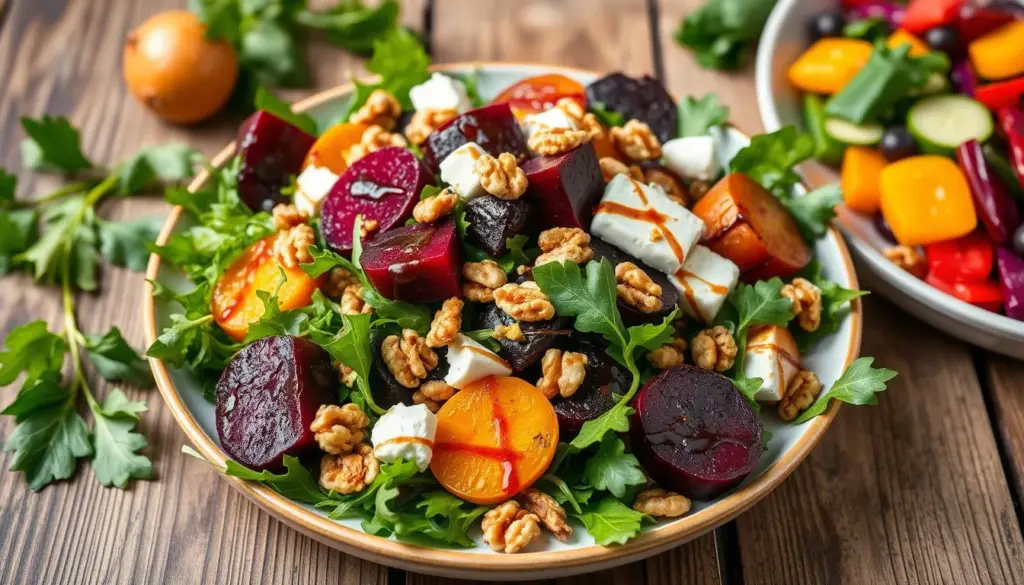
The Story and Origins
Beets have a long history in French cooking. They are prized for their rich flavor and health benefits. The Balthazar Beet Salad honors this tradition, blending old-world charm with modern tastes.
Health Benefits
Adding beets to your meals can be very beneficial. They are packed with fiber and folate, making them great for salads. Beets also support heart health and overall well-being, making the Balthazar Beet Salad a nutritious choice.
Key Highlights of Balthazar Beet Salad Recipe
- Ingredients: The salad combines roasted or pickled beets with goat cheese and crunchy walnuts.
- Dressing: A classic French vinaigrette adds a sophisticated touch to the flavors.
- Visual Appeal: The salad’s presentation, with large beet cubes, is visually stunning.
- Flavor Profile: The sweetness of the beets pairs well with the tanginess of the cheese, while walnuts add a nice crunch.
This Balthazar Beet Salad offers a delightful combination of earthy flavors and fresh ingredients. Discover the full recipe at: Balthazar Beet Salad Recipe.
Shepherd’s Pie Recipe with Velveeta Cheese – British Origin With an American Twist
Shepherd’s Pie is a beloved British comfort food. It comes from Scotland and northern England, dating back to the late 1700s. Originally made with leftover lamb or mutton, it has evolved in America with the addition of creamy Velveeta cheese.

The Story and Origins
The term “Shepherd’s Pie” gained popularity in the mid-19th century. It’s different from “Cottage Pie,” which uses minced beef. The early version had a potato crust, often made from Russet and Red Potatoes. Today, many use ground lamb from local farms, supporting local agriculture.
Health Benefits
Shepherd’s Pie is a balanced meal. It has lean meats, mixed vegetables, and mashed potatoes. These ingredients add vitamins and minerals to your diet, making it great for families looking for healthy meals.
Key Highlights of Shepherd’s Pie Recipe with Velveeta Cheese
- Traditional Shepherd’s Pie features ground lamb or beef and a topping of creamy mashed potatoes.
- The addition of Velveeta cheese creates a rich, creamy cheese element that elevates the flavor profile.
- Shepherd’s Pie preparation steps include browning the meat, layering with vegetables such as carrots, peas, and onions, and then topping with a decadent cheese-infused mashed potato layer.
- After baking until golden, you are left with a meal that radiates comfort and satisfaction, perfect for gatherings or cozy nights in.
Try this comforting Shepherd’s Pie recipe with a unique twist using Velveeta cheese. Get the full recipe here: Shepherd’s Pie Recipe with Velveeta Cheese.
Churu Chicken Amarillo Recipe – Peruvian Chicken Dish With Amarillo Chili
The Churu Chicken Amarillo is a vibrant dish from Peruvian cuisine. It uses amarillo chili, known for its fruity taste and medium heat. To make it, chicken thighs are marinated in a paste of aji amarillo, garlic, and lime juice.

The Story and Origins
This dish celebrates amarillo chili peppers in Lima. It combines chicken, spices like cumin and paprika, and fresh veggies. The preparation is simple, taking under an hour, making it perfect for family dinners.
Health Benefits
Churu Chicken Amarillo is not just tasty but also healthy. It’s a lean protein source. The amarillo chili adds vitamins C and A, supporting metabolism and health. It’s a great choice for a healthy meal.
Key Highlights of Churu Chicken Amarillo Recipe
This recipe maritates 1 kg of chicken for 30 minutes. Then, it’s roasted at 375°F until it’s 165°F inside. It’s served with rice or boiled potatoes. The whole process takes about 45 minutes, making it a comforting and spicy meal.
Discover the bold flavors of Churu Chicken Amarillo with this delicious recipe. Try it out here: Churu Chicken Amarillo Recipe.
FAQ
What are cultural recipes?
Cultural recipes are dishes that have been passed down through generations. They show the culinary heritage and identity of a specific region or culture. These recipes often use unique ingredients and cooking methods that reflect local history and traditions.
Why are these recipes significant?
These recipes are important because they tell stories and preserve heritage. They connect people to their cultural roots. They also bring families and friends together, as they share these beloved dishes during special occasions.
How can I incorporate these recipes into my cooking?
To add these recipes to your cooking, start by finding quality ingredients. Follow the steps given in the recipe. Feel free to experiment with flavors and adjust the recipe to your liking, while keeping its cultural essence.
Are there health benefits associated with these cultural recipes?
Yes! Many of these recipes use ingredients that are good for your health. For example, sauerkraut is great for your gut, and ceviche is high in protein but low in calories. Each recipe highlights the health benefits of its main ingredients.
Can I find substitutes for hard-to-find ingredients?
Absolutely! You can find substitutes for ingredients that are hard to find. For instance, if you can’t find a certain fish, you can use another high-quality fish that matches the flavor.
What makes a recipe a “must-try” cultural recipe?
A “must-try” cultural recipe captures the essence of its cuisine. It features unique flavors and ingredients. It also tells a compelling story about the culture it comes from. These recipes offer a rich culinary experience and often bring a sense of nostalgia and connection to tradition.
